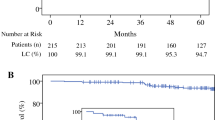Abstract
Background
Intraoperative radiotherapy (IORT) is promising approach that is being tested in randomised clinical trials. In the Targit (TARGeted Intraopeartive radioTherapy) trial IORT can be delivered at the time of primary surgery or as a second procedure. Patients prefer the single procedure of intraoperative radiotherapy even if it is under general anaesthetic to 6-weeks of daily visits for conventional external beam radiotherapy.
Case presentation
We report a case of a 70 year lady who underwent lumpectomy and axillary sampling and in whom we successfully administered IORT under local anaesthetic.
Conclusion
In selected patients, this attractive option may make the procedure even more widely applicable.
Similar content being viewed by others
Background
Partial breast irradiation for breast cancer is being tested in randomised trials[1]. In the TARGIT trial [2] patients can receive the TARGeted Intraoperative radioTherapy either during the primary operation or as a second procedure. Over 300 patients have been randomised in this multi-centre trial to date.
Case presentation
A 70 year old lady who had a lumpectomy and axillary sample for a 2.8 cm, grade II, node-negative breast cancer was with her consent, entered into the trial. She was randomised to receive intraoperative radiotherapy as a second procedure. However, the attending anaesthetist felt that because of the history of severe ischaemic heart disease a second general anaesthetic should be avoided. The patient was keen to take the intraoperative radiotherapy to which she was randomised, rather than come every day for radiotherapy for 6 weeks; she was willing to undergo the whole procedure under local anaesthetic.
She received temazepam (10 mg), preoperatively. She was given midazolam 1 mg i.v. just prior to infiltration of the scar (just the skin) with 1% lignocaine with 1:200,000 adrenaline and 0.5% marcaine in a ration of 1:1. During the infiltration she breathed a 50:50 mixture of oxygen and nitrous oxide, followed by oxygen @ 6 L/min via Hudson mask.
The cavity was opened and radiotherapy applicator positioned with a purse string suture as usual. The patient did not feel any pain and tolerated the procedure well (figure 1). She remained still during the 22 minutes while radiotherapy (20 Gy at surface) was delivered to the tumour bed (figure 2). Postoperative period was uneventful and we discharged home a happy patient.
Discussion
Delivering intraoperative radiotherapy ("targiting") as a second procedure allows proper selection of patients because detailed histopathology is available. The approach can also extend the applicability of intraoperative radiotherapy to patients who have already had operation in other centres. The Targit technique with Intrabeam(TM) delivers radiotherapy from within the tumour bed and does not require extensive dissection of breast tissue; it is therefore feasible under a local anaesthetic. If the Targit trial is successful, it is likely that many suitable patients will have significant co-morbidities and a second general anaesthetic would be ideally avoided. It appears that this is possible in selected patients.
References
Vaidya JS, Tobias JS, Baum M, Wenz F, Kraus-Tiefenbacher U, D'Souza D, Keshtgar M, Massarut S, Hilaris B, Saunders C, Joseph D: TARGeted Intraoperative radiotherapy (TARGIT): an innovative approach to partial-breast irradiation. Semin Radiat Oncol. 2005, 15: 84-91. 10.1016/j.semradonc.2004.10.007.
Vaidya JS, Baum M, Tobias JS, Houghton J: Targeted Intraoperative Radiothearpy (TARGIT)- trial protocol. Lancet. 1999, http://www.thelancet.com/journals/lancet/misc/protocol/99PRT-47-http://www.thelancet.com/journals/lancet/misc/protocol/99PRT-47
Acknowledgements
Written permission was obtained from the patient for publication of her photographs
Author information
Authors and Affiliations
Corresponding author
Additional information
Competing interests
The author(s) declare that they have no competing interests.
Authors’ original submitted files for images
Below are the links to the authors’ original submitted files for images.
Rights and permissions
Open Access This article is published under license to BioMed Central Ltd. This is an Open Access article is distributed under the terms of the Creative Commons Attribution License ( https://creativecommons.org/licenses/by/2.0 ), which permits unrestricted use, distribution, and reproduction in any medium, provided the original work is properly cited.
About this article
Cite this article
Vaidya, J.S., Walton, L. & Dewar, J. Single dose targeted intraoperative radiotherapy (TARGIT) for breast cancer can be delivered as a second procedure under local anaesthetic. World J Surg Onc 4, 2 (2006). https://doi.org/10.1186/1477-7819-4-2
Received:
Accepted:
Published:
DOI: https://doi.org/10.1186/1477-7819-4-2





